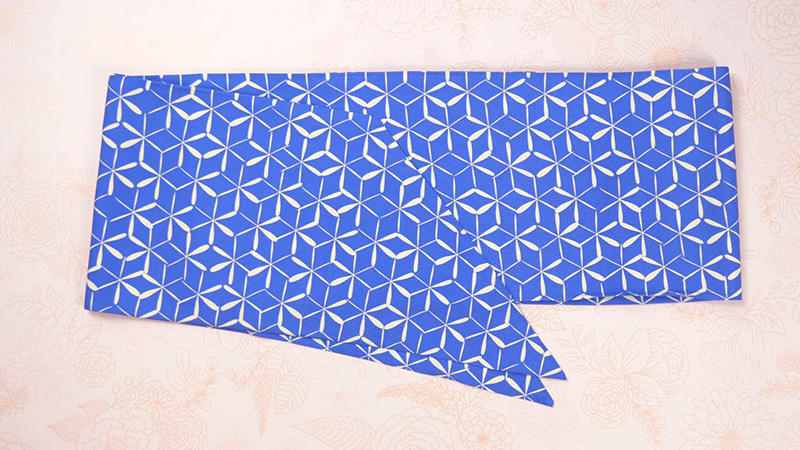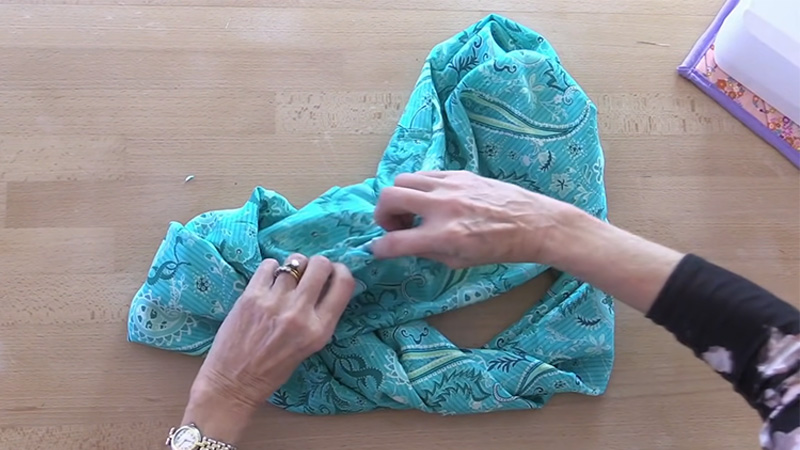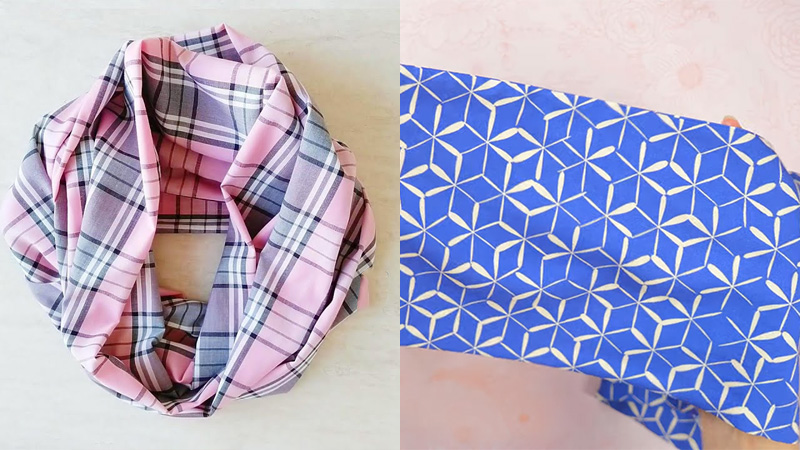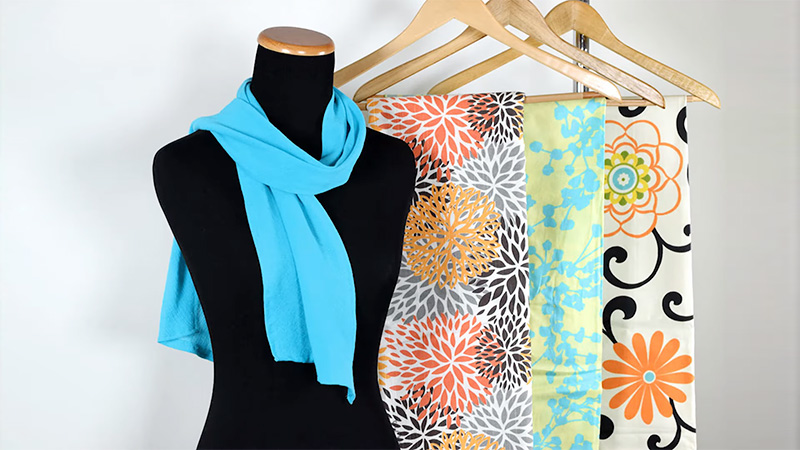Sewing a scarf is a delightful and rewarding DIY project that allows you to create stylish, personalized accessories for yourself or loved ones. Scarves are not only functional, providing warmth and comfort in colder months, but they also serve as fashion statements year-round.
Learning how to sew a scarf opens up a world of creative possibilities, enabling you to select fabrics, colors, and designs that perfectly match your style and the seasons.
In this guide, we will explore various methods for sewing scarves, from simple, straight-stitched designs to more intricate creations featuring embroidery, patchwork, and unique twists.
Whether you’re a seasoned sewing enthusiast or a beginner with a passion for crafting, sewing a scarf is a fulfilling endeavor that allows you to showcase your creativity and fashion sensibilities.
So, gather your materials, thread your needle, and embark on a sewing journey that will not only keep you warm but also elevate your fashion game.

How To Sew A Scarf?
Here are some simple methods for sewing a scarf-
Basic Straight Stitch Scarf
Start by selecting your favorite fabric, typically lightweight and soft materials like cotton or chiffon. Cut a rectangular piece of fabric to your desired scarf size, adding a 1/2-inch seam allowance on all sides.
Fold the edges of the fabric inwards by 1/4 inch, then fold them again by another 1/4 inch to create a clean edge. Secure the folds with pins and use a straight stitch on your sewing machine or hand-sew along the edges to finish the scarf.
Fringed Scarf
To create a fringed scarf, choose a fabric with a loose weave, like flannel or plaid. Cut the fabric into a rectangle with the desired dimensions. Make small, evenly spaced snips along the short ends of the fabric, about 1 inch apart and 1 inch deep.
Gently pull on each thread in the fringed area to create the fringe. Knot the threads at the ends to prevent unraveling.
Infinity Scarf
An infinity scarf is a closed-loop scarf that you can make by sewing the short ends of a rectangular piece of fabric together. First, fold the fabric in half lengthwise, with the right sides facing each other, and sew the long edge.
Turn it right side out, creating a tube. Sew the open short ends together, and you’ll have an infinity scarf.
Patchwork Scarf
For a patchwork scarf, gather various fabric scraps in complementary colors and patterns. Cut the scraps into squares or rectangles of the same size.
Sew the pieces together, right sides facing each other, to create a larger patchwork fabric. Finish the edges as desired with a folded hem or fringe.
Embellished Scarf
Begin with a plain scarf made of a suitable fabric like silk or satin. Add embellishments such as lace trim, sequins, beads, or embroidery to create a unique design. Hand-stitch or use fabric glue to secure the embellishments in place.
Reversible Scarf
A reversible scarf consists of two layers of fabric sewn together along the edges. Choose two complementary fabrics, cut them to the same size, and place them right sides together.
Sew around the edges, leaving a small opening to turn the scarf right side out. Stitch the opening closed, and you’ll have a scarf with two distinct sides.
Pom-Pom Trim Scarf
Make a playful scarf by sewing pom-pom trim along the edges. Start with a plain fabric scarf and carefully sew the pom-pom trim to the edges using a straight stitch.
Be sure to catch the trim and fabric securely. This whimsical addition adds a fun and decorative touch to your scarf.
These seven methods offer a variety of options for sewing scarves to suit different styles and preferences. Whether you prefer a simple, classic design or want to experiment with embellishments and textures, sewing your scarf allows you to create a personalized accessory to keep you cozy and stylish.
Materials Needed To Sew A Scarf

Here’s a table listing the materials you’ll need for sewing a scarf:
| Material | Description |
| Fabric | Choose a fabric of your choice (e.g., cotton, wool, silk) for the scarf. |
| Sewing machine | For efficient and neat stitching. |
| Thread | Matching or contrasting thread for sewing. |
| Fabric scissors | For cutting the fabric to the desired length and width. |
| Pins or clips | To hold the fabric layers together while sewing. |
| Measuring tape or ruler | For measuring and marking the fabric. |
| Iron and ironing board | For pressing and straightening the fabric. |
| Needle and thread (optional) | For hand-sewing any details or finishing touches. |
| Fray check or seam sealant (optional) | To prevent fabric edges from fraying. |
| Decorative elements (optional) | Tassels, beads, or embroidery for embellishing the scarf. |
| Fabric marker or chalk (optional) | For marking sewing lines or patterns. |
| Safety pins (optional) | For attaching any decorative elements securely. |
| Template or pattern (optional) | If you’re using a specific design for your scarf. |
These materials will help you create a unique and customized scarf to suit your style and preferences. The choice of fabric, color, and design is entirely up to you, allowing for a personalized and creative sewing project.
What Are Some Of The Best Fabrics To Make A Scarf?

Here are some of the best fabrics for making scarves-
Cotton
Cotton is a classic choice for scarves due to its breathability and versatility. It’s soft against the skin, making it comfortable to wear year-round.
Lightweight cotton is perfect for warm-weather scarves, while flannel or brushed cotton offers warmth and coziness in cooler seasons.
Silk
Silk is synonymous with luxury and elegance. It’s a perfect choice for creating lightweight, lustrous scarves that drape beautifully. Silk scarves are often chosen for formal occasions or to add a touch of sophistication to everyday outfits.
Wool
Wool is an excellent option for winter scarves. It’s warm, insulating, and provides excellent protection against cold weather. Choose fine merino wool for a soft and non-itchy feel against the skin, or opt for thicker wool blends for extra warmth.
Cashmere
Cashmere scarves are renowned for their incredible softness and warmth. Made from the fine fibers of cashmere goats, these scarves are lightweight yet exceptionally cozy. They are perfect for chilly weather and add a touch of luxury to any outfit.
Chiffon
Chiffon is a lightweight and sheer fabric that’s ideal for creating delicate and airy scarves. It’s often used for summer scarves or as an elegant accessory for special occasions. Chiffon scarves can be layered for a graceful, ethereal look.
Jersey Knit
Jersey knit scarves are casual, comfortable, and have a natural stretch. They are easy to work with and create scarves with a relaxed drape. Jersey knit scarves are a popular choice for everyday wear, offering a blend of comfort and style.
Linen
Linen scarves are perfect for warm-weather accessorizing. Linen is breathable, moisture-wicking, and has a natural texture that adds a rustic charm to your outfit. It’s a great choice for achieving a relaxed, beachy, or bohemian look.
Each of these fabrics offers distinct qualities, allowing you to choose the best one based on your preferences, the season, and the intended use of your scarf.
Whether you’re looking for warmth, elegance, breathability, or texture, there’s a fabric that can help you create the perfect scarf for any occasion.
Design Ideas To Sew A Scarf?

Here are some creative design ideas for sewing scarves-
Color-Blocked Scarf
Create a striking color-blocked scarf by sewing together contrasting or complementary fabric panels. Choose two or more fabric colors or patterns and cut them into equal-width strips or rectangles.
Sew the panels together lengthwise, creating a scarf with bold, eye-catching blocks of color or pattern. This design allows you to play with color combinations to suit your style.
Infinity Scarf with a Twist
Put a unique twist on the classic infinity scarf by adding a subtle twist or Mobius strip design. After sewing the scarf’s short ends together to create the loop, give it a half-twist before sewing the ends together again.
This twist creates an intriguing and stylish variation on the traditional infinity scarf.
Embroidered Personalized Scarf
Personalize your scarf by adding delicate embroidery. Select a solid or lightly patterned fabric and use embroidery floss to add your initials, a meaningful word, or a decorative design.
Hand embroidery allows you to create a one-of-a-kind scarf with a personalized touch, making it a cherished accessory.
Patchwork Quilt Scarf
Craft a cozy patchwork quilt scarf by sewing together small fabric squares or rectangles. Mix and match fabric patterns, colors, and textures to create a visually appealing patchwork design.
This style adds warmth and character to your scarf, making it perfect for cold winter days.
Oversized Blanket Scarf
Make a fashion statement with an oversized blanket scarf. Choose a soft and warm fabric like flannel or wool and cut it into a large square or rectangle. Hem the edges or add fringe for a rustic touch.
This scarf style is not only cozy but also versatile, allowing you to wear it as a shawl or wrap.
Two-Tone Reversible Scarf
Craft a reversible scarf with two distinct sides by sewing together two different fabric pieces. You can have one side in a solid color and the other in a complementary pattern, allowing you to switch up your look effortlessly. This design doubles the scarf’s versatility.
Pleated Accordion Scarf
Add elegant pleats to your scarf by sewing in accordion-style pleats along its length. These pleats create a sophisticated texture and dimension. While it may require some precision in sewing, the result is a visually striking and stylish scarf.
These design ideas offer a range of options to unleash your creativity and make scarves that reflect your personal style and preferences.
Whether you’re drawn to bold colors, intricate embroidery, or cozy patchwork, there’s a sewing project to suit your fashion vision.
FAQs
Do I need advanced sewing skills to make a scarf?
No, you don’t need advanced sewing skills. Many scarf designs, like the basic straight-stitched scarf or fringed scarf, are beginner-friendly and require only basic sewing techniques.
What type of fabric should I choose for sewing a scarf?
The fabric choice depends on the season and style you prefer. Cotton, silk, and chiffon are excellent for lightweight scarves, while wool and flannel provide warmth for colder months.
Can I add embellishments like embroidery or sequins to my scarf?
Absolutely! You can personalize your scarf with various embellishments like embroidery, sequins, or fabric paint. These additions allow you to create a unique and stylish scarf that reflects your personality and creativity.
What’s the best stitch for sewing a scarf’s edges?
A straight stitch or a zigzag stitch works well for sewing the edges of most scarves. These stitches help prevent fraying and provide a clean finish. Be sure to use a thread color that complements your fabric.
Are there any no-sew scarf options for beginners?
Yes, there are no-sew scarf options for beginners. You can create scarves by using fabric glue to secure hems and seams or by repurposing existing fabric items into scarves.
Conclusion
As you conclude your sewing adventure with scarves, you’ve not only created functional and fashionable accessories but also honed your crafting skills and unleashed your artistic spirit. Handmade scarves are not just fabric and thread; they are expressions of your personality, style, and creativity.
Wearing or gifting a scarf that you’ve sewn carries a unique sense of pride and accomplishment. Each stitch represents your craftsmanship and attention to detail.
Whether you’ve opted for a classic design or experimented with unique embellishments, your scarves are a testament to your ability to turn fabric into wearable art.
So, wrap yourself in the warmth and style of your handmade scarves, knowing that you’ve embarked on a creative journey that will continue to inspire and uplift you.
May your scarves serve as both functional companions and timeless reminders of your passion for sewing and self-expression.
Leave a Reply